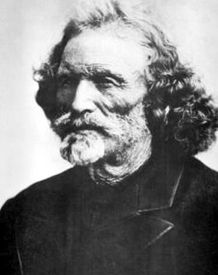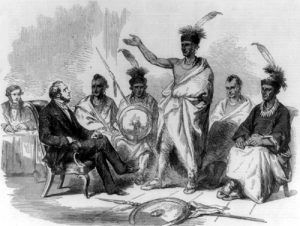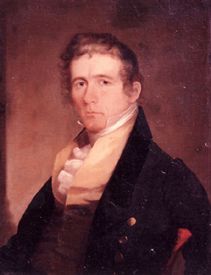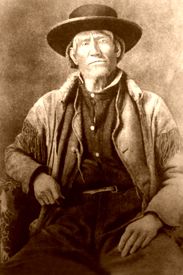William Allison (??- 1859) – Along with Francis Boothe, Allison built an adobe trading post in 1855 near present-day Great Bend, Kansas, which was the only non-military supply station west of Council Grove on the trail. Two years later, Boothe would be murdered by a traveler who split his head open with an ax. Allison continued to prosper at the trading post, as in 1858, the Pike Peak Gold rush brought another boom of migration; however, he would have a heart attack and die while on a trip to Missouri in 1859.
Francois Xavier Aubry (1824-1854) – Aubry was a French Canadian merchant, wagon train captain, and explorer of the American Southwest. His achievements include speed records riding the Santa Fe Trail and early exploration of the 35th parallel northwest of the North American continental divide.
Giovanni Maria Augustini (1801-1869) – An Italian priest who came to America and wandered from one Indian tribe to another, teaching the gospel and administering the last sacrament to people on the Santa Fe Trail. He lived for a time in what’s now called Hermit’s Cave in Council Grove, Kansas, and later atop a mountain in New Mexico, known as Hermit’s Peak.

Jim Baker, mountain man
Jim Baker (1818-1898) – One of the most colorful figures of the Old West, Baker was a trapper, scout, and guide, a friend of Jim Bridger and Kit Carson and one of General John C. Fremont’s favorite scouts.
Dona Gertrudis “La Tules” Barcelo (1800-1852) – A saloon owner and master gambler in the Territory of New Mexico during the Mexican-American War. She amassed a small fortune by capitalizing on the flow of American and Mexican traders involved with the Santa Fe Trail.
Alexander Barclay (1810-1855) – Alexander Barclay was a British adventurer who immigrated to America to pursue his dream of adventure. He built Barclay’s Fort along the Santa Fe Trail in New Mexico.
William Becknell (1788-1856) – Known as the “Father of the Santa Fe Trail,” Becknell was the first to blaze the path. He was also a frontiersman, trader, soldier, and politician.
James Pierson Beckwourth(1798-1860) – A mulatto born into slavery in Virginia, he was freed by his father (and master) and later move to the American West, where he became a mountain man, fur trader, and explorer.
William Bent (1809-1869) – The younger brother of Charles Bent, William was born in St. Louis, Missouri, in 1809. The brothers established Bent’s Fort in Colorado in 1833 to trade with the Plains Indians and area trappers.
Albert Gallatin “A.G.” Boone– Trapper, Trader, Pro-slavery advocate, and Indian Agent.
Francis Boothe (?? – 1857) – Along with William Allison, Boothe built the only non-military supply station west of Council Grove along the Santa Fe Trail in 1855, near present-day Great Bend, Kansas. Booth would be murdered in 1857 by a Mexican traveler on the trail who split his head with an ax.
James Bridger (1804-1881) – An accomplished trapper, scout, and mountain man, Bridger was one of the first non-Indians to see the natural wonders of what would become Yellowstone Park.
Christopher “Kit” Carson (1809-1868) – Carson was a daring and brave explorer, mountain man, trapper, scout, soldier, and buffalo hunter.
Buffalo Bill Cody (1946-1917) – Soldier, buffalo hunter, and entertainer, Buffalo Bill often traveled the Santa Fe Trail.
Malcolm Conn (1831-1898) – One of the wealthiest men in Council Grove, Kansas, during the busy Santa Fe Trail days, Conn owned what was known as the Pioneer Store. He later served as Morris County Clerk and Treasurer of the Town Company that platted Council Grove.
Josiah Gregg (1806-1850) – Trader, explorer, and writer; he is best known for his book, Commerce on the Prairies, which described his adventures along the Santa Fe Trail.
Seth M. Hays (1811-1873) – The first white settler of what was to become Council Grove, Kansas, Hays would make a large contribution to Council Grove and the Santa Fe Trail.
Wild Bill Hickok (1837-1876) – Better known as a lawman and gunfighter, Hickok often made his way along the Santa Fe Trail.
Captain James Hobbs (1819-1880) – Also known as Comanche Jim, Hobbs was the Great-grandson of renowned Shawnee Indian Chief, Tecumseh. Starting as a fur trader, he would later spend time with the likes of Kit Carson before becoming a Texas Ranger and fighting in the Mexican-American and Civil Wars.

The Kanza or Kaw Indians
Kanza/Kaw Tribe – From a period extending far back into the past — far back of any written record — the Kanza claimed, as a nation, the region that they ceded to the United States by the treaty of June 1825. They were moved to a reservation in Kansas before being forced into Indian Territory (Oklahoma) in 1873.
William E. Mathewson (1830-1916) – Though not as well known in history as the more famous “Buffalo Bill” Cody, the first man to hold the moniker of Buffalo Bill was William E. Mathewson, a daring explorer, hunter, Indian scout and fighter, who did much to prepare the pathway for western expansion.
Lucien Bonaparte Maxwell (1818-1875) was a rancher and entrepreneur who, at one point, owned more than 1,700,000 acres, called the Maxwell Land Grant. His headquarters were located at Cimarron, New Mexico, along the Santa Fe Trail. He was one of the largest private landowners in United States history.
Fry P. McGee (1816-1861) – An influential man from Westport, Missouri, McGee established the 110 Mile Creek Crossing in Osage County, Kansas.
Osage Tribe – On June 2, 1825, the Osage Nation relinquished its title to all the lands it still claimed in Missouri and Arkansas, and in addition, ceded to the United States “all lands lying west of Missouri and Arkansas, north and west of the Red River, south of the Kansas River, and east of a line to be drawn from the head sources of the Kansas River southwardly through the Rock Saline.”

George C. Sibley
George C. Sibley (1782-1863) – An American explorer, soldier, Indian agent, politician, and educator who surveyed the Santa Fe Trail.
Tom Tate Tobin (1823-1904) – A frontiersman, trapper, mountain man, and scout, he explored and scouted in the New Mexico and Colorado areas. He associated with men such as Kit Carson, “Uncle Dick” Wootton, Ceran St. Vrain, Charley Bent, John C. Fremont, “Wild Bill” Hickok, William F. Cody, and the Shoup brothers.
Samuel B. Watrous (1909-1886) – Rancher and farmer of Mora County, New Mexico for whom the town of Watrous is named. After a long and successful life living along the Santa Fe Trail, he was killed by two gunshots to the head, which remains a mystery today.
Charles H. Withington (1816-1881) – A blacksmith for the Sac and Fox Indians, Withington was the first white settler in Lyon County, Kansas. There, he operated a successful store along the trail and served as a mail agent.
Richens Lacy “Uncle Dick” Wootton (1816-1893) – American frontiersman, mountain man, trapper, and guide, Wootton worked for a time at Bent’s Fort in Colorado before building a 27-mile toll road over Raton Pass in New Mexico.
Hiram Young – (c. 1812-1882) – An African-American entrepreneur, Young was one of the leading manufacturers of wagons in Independence, Missouri, for westward pioneers in the mid-19th century.
© Kathy Weiser/Legends of America, updated May 2021.
Also See:
Famous Men of the Santa Fe Trail
Heroes of the Old Santa Fe Trail
Sources: See Santa Fe Trail Site Map & Writing Credits

